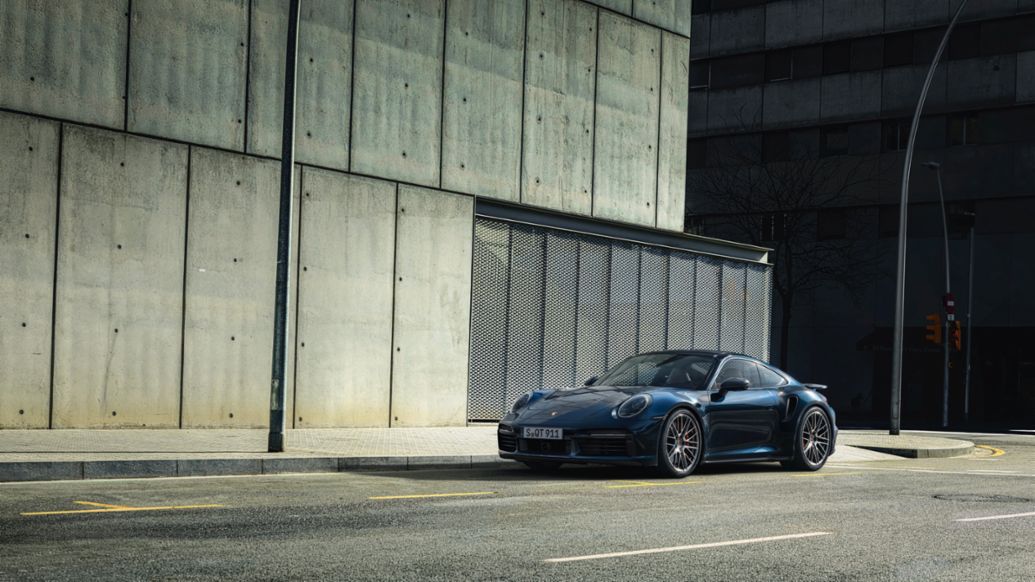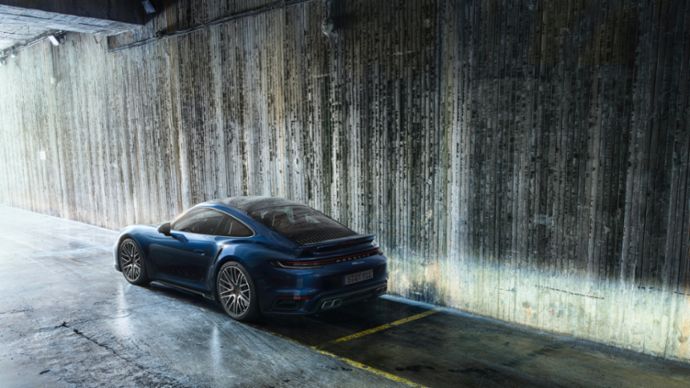Thanks to their 427 kW (580 PS; 911 Turbo: Fuel consumption combined 11.1 l/100 km, CO2 emissions combined 254 g/km; 911 Turbo Cabriolet: Fuel consumption combined 11.3 l/100 km, CO2 emissions combined 257 g/km) engines, 30 kW (40 PS) more than their predecessors, both model variants dip under the magic three second 0-100 km/h mark with a time of 2.8 seconds (0.2 seconds faster). 750 newton metres of torque (up 40 Nm), now without an overboost time limit, make quick sprints even more spontaneous and effortless.
Acceleration, power output and torque of the new 911 Turbo therefore all match those of the previous generation 911 Turbo S. Power transmission is performed by an eight-speed PDK gearbox with a Turbo-specific set-up while its top speed remains unchanged at 320 km/h. Options such as the Sports and Lightweight Design packages, sports chassis and sports exhaust system are available for the 911 Turbo for the first time. As a result, customers will be able to adapt their vehicle even more to their individual tastes.

The new sports cars are following in prestigious footsteps as the 911 Turbo has been synonymous with luxury and performance since 1975. Each generation has continued to live up to the claim of being a global benchmark for high-performance sports cars. The 911 Turbo combines sportiness with everyday usability, emotive dynamism with reliability and exhilarating performance with efficiency. The latest generation of the two-plus-two seater is more than twice as powerful as the original Turbo, which was powered by a three-litre, single-turbocharged, 260 PS flat six. While the 911 Turbo may have become faster, larger and more comfortable over the years, it has always retained its fundamental characteristics.
Improved responsiveness and performance
The new 911 Turbo’s 3,745 cm3 six-cylinder boxer engine boasts an increased output of 580 PS (911 Turbo: Fuel consumption combined 11.1 l/100 km, CO2 emissions combined 254 g/km; 911 Turbo Cabriolet: Fuel consumption combined 11.3 l/100 km, CO2 emissions combined 257 g/km) and now features symmetrical VTG turbochargers with electrically controlled bypass valves. In conjunction with its redesigned charge air cooling system and the use of piezo injectors, this improves responsiveness, performance, torque characteristics and its ability to rev freely. The chassis and body have become wider. The front axle now steers even more precisely thanks to an additional 42 millimetres of front track width and new 20-inch 255/35 tyres.

The active all-wheel control PTM is now able to transfer even more power to the front wheels while traction at the actively steered rear axle is increased by a 10 mm-wider track as well as 315/30 tyres on 21-inch wheels – one inch more than on the front axle. The revamped braking system is even more powerful and can be recognised by its red fixed callipers that are fitted as standard. The grey cast iron brake discs at the front now measure 408 mm in diameter (28 mm more than before) and are 36 mm thick (two millimetres more). The rear axle features 30 mm-thick brake discs with a diameter of 380 mm.
Two different chassis variants
A sports exhaust system is optionally available on the 911 Turbo for the very first time. Two different chassis variants are also new: while the standard PASM chassis offers a greater spread between sportiness and comfort, the significantly firmer, electrically controlled 10 mm-lower sports suspension benefits the agility of the new 911 Turbo. Its set-up is aimed at enhancing the car’s dynamics and provides even more stability in high-speed driving, such as when the vehicle is used on race circuits. The optional PDCC hydraulic active anti-roll stabilisation and PCCB ceramic brake system with ten-piston fixed callipers at the front refine the new model’s driving dynamics yet further.





No comments:
Post a Comment